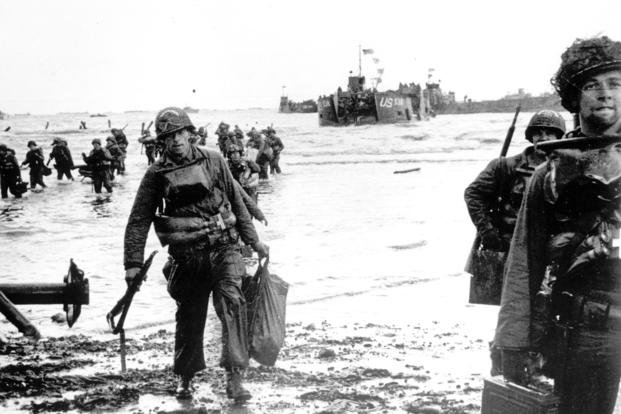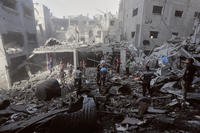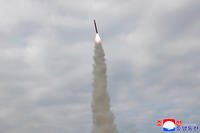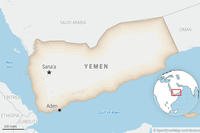D-Day Remembered
We were told the Germans might use poison gas.
Written in 2017 by Robert Louis Curl (1925-2023)
My name is Robert Louis Curl. I was born on June 28, 1925, in Warrior, Alabama, and now live in Birmingham, Alabama. When I was 17 years old, I graduated from Minor High School on a Friday night and joined the Navy the next morning, on June 4, 1943.
I received boot training at Bainbridge, Maryland, and navigational radar training at Woods Hole, Massachusetts. From there, I was sent to amphibious training at Little Creek, Virginia. We were formed into crews, and each crew was sent to Brooklyn Navy Yard to pick up a new Landing Craft Control (LCC). Our crew was made up of all petty officers except the skipper, Lt. Tinsley, and an executive officer, Ensign Kirchoff.
We had a quartermaster, signalman, sonarman, two radiomen, two machinist-mates and three gunner's mates. There were only two bunks on this 56-foot craft. We survived on K and C rations for three weeks in Normandy. Usually we were land-based most of the time. Nine of these Landing Craft Control LCC's were built -- five for the Atlantic Operations and four for the Pacific Operations.
I was separated from my crew and assigned to accompany three of these boats on a Liberty ship headed for Plymouth, England. We arrived in February 1944 and trained for amphibious landing until about the middle of May 1944. I was again separated from my crew and sent to Falmouth, England, for [Operation] Overlord briefing. There was a scale model of Omaha Beach that showed everything about the area.
Everything was to scale -- buildings, roads, fences and even grass. I studied maps of Omaha Beach. With the small map that was issued after we embarked for Normandy, I was to superimpose the radar image over the map and find the correct landing place on Omaha Beach. We used a Virtual Image Plan Position Indicator Reflectoscope to accomplish this.
Each of the five Landing Craft Controls was assigned to lead in the first wave on each of five beach areas. My LCC 1O was assigned to lead in the first wave on Omaha Beach and stay there 1,000 yards off the beach for each successive wave to follow us. We were told the Germans might use poison gas, and we were to wear impregnated clothing and armbands that would detect poison gas.
I was sent to join my crew at Weymouth on June 1, 1944, and we were quarantined in this area.
On June 5, we started across the English Channel, leading a group of LCTs loaded with DD tanks. We had to leave early because we could only travel at five knots. We were told to return to Weymouth because of heavy seas. We left again on June 6 and were followed by thousands of ships, all carrying barrage balloons attached to the ships with steel cables.
The ships rendezvoused several miles offshore and began the bombardment from battleships, cruisers and destroyers. The soldiers were to climb down large cargo nets from the deck of the troopships to the landing crafts below. Ten or 15 men could descend at the same time.
This maneuver, however, was almost impossible due to the huge waves and swells. The landing craft would rise almost to the deck of the ship, riding the crest of a wave, so any men on the nets at the time would have been crushed against the side of the ship.
The men began to wait until the landing craft rose and then jumped from the ship to the landing craft. Many men wound up with broken bones and other injuries since the timing of the jump was crucial. After the sea calmed, they resumed the transfer by climbing down the cargo nets.
We began leading the first wave into the beach as the bombardment began. The large projectiles flying overhead looked like footballs. We recovered the bodies of numerous soldiers who had drowned, because the sea swells sank their DD tanks. Things were not going well early that morning. Many of the LCVPs [landing craft, vehicle, personnel] and LCMs [landing craft mechanized] were hung on the hedgehogs that the Germans had installed on the beach. We, and also the landing craft, were being fired on from the pillboxes. I saw an American destroyer turn and proceed backward to the beach and come in as close as we were. It knocked out a German pillbox that had been causing havoc.
About sundown that first day, two German planes came in strafing Omaha Beach and amazingly did not strike a single steel cable that was attached to the many barrage balloons.
A few days later, we were directed to do hydrographic work for the sinking of several old Liberty ships and one French battleship in order to form a breakwater harbor for the landing supplies. We were recommended for the Bronze Star for this work, but as far as I know, none of us ever received one.
After three weeks, we were dispatched to Corsica and Sardinia to prepare to lead the first wave in the invasion of Southern France. Three months after the successful invasion, we were sent home to the states on 30 days' leave.
I was then assigned to a new rocket ship LSM(R) 408 that was equipped with gyro-stabilized rocket launchers. We went through the Panama Canal, headed for the West Coast. There we practiced shelling San Clemente Island in preparation for the invasion of Japan. We had almost reached Eniwetok when the atomic bomb was dropped. This, of course, ended the war. We were sent stateside, and I was honorably discharged in March of 1946.
Robert Curl passed away on November 25, 2023 at the age of 98 in Hueytown, Alabama.
Want to Know More About the Military?
Be sure to get the latest news about the U.S. military, as well as critical info about how to join and all the benefits of service. Subscribe to Military.com and receive customized updates delivered straight to your inbox.











